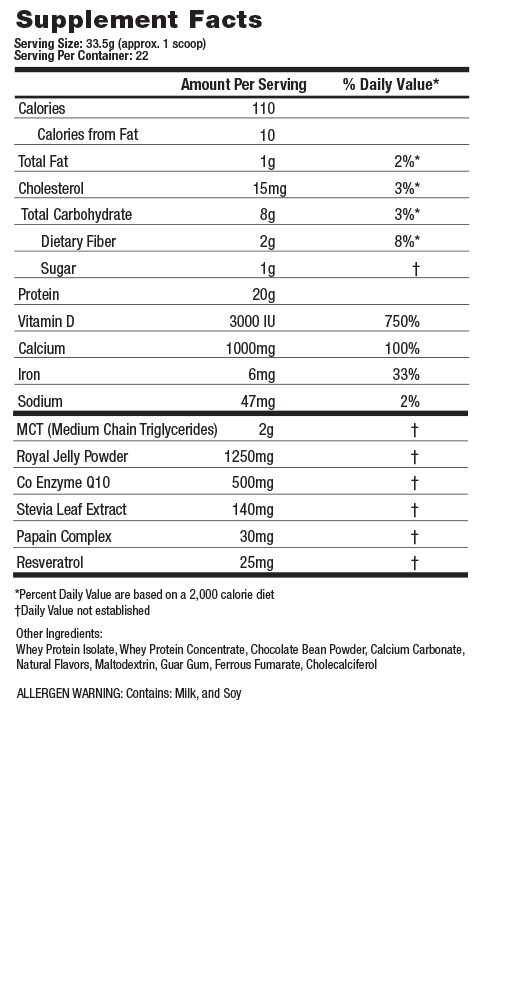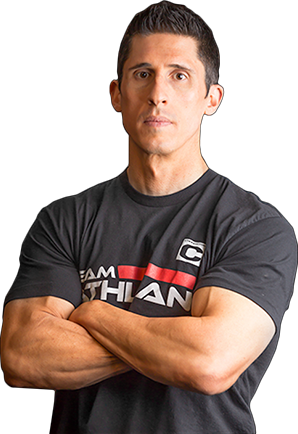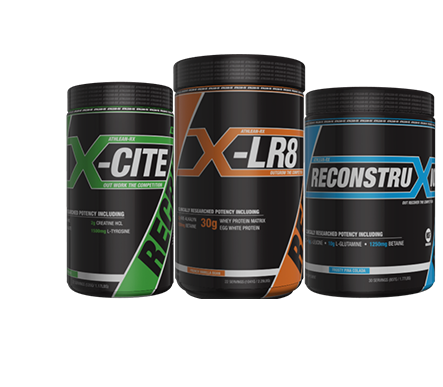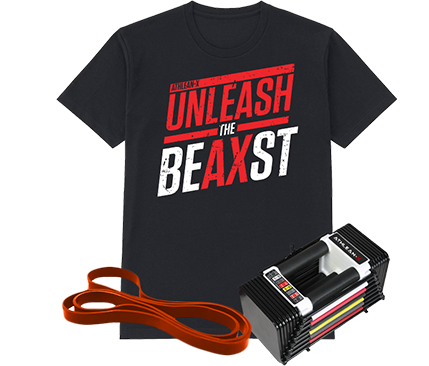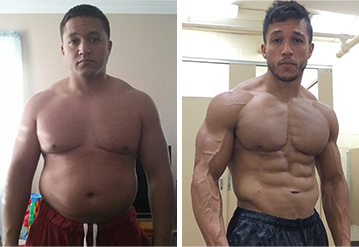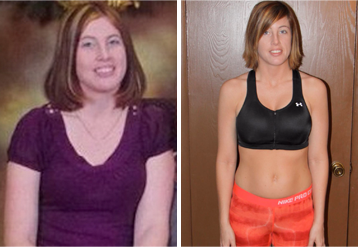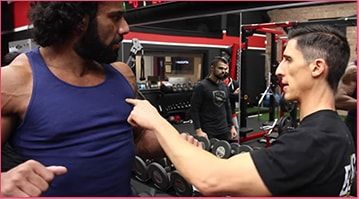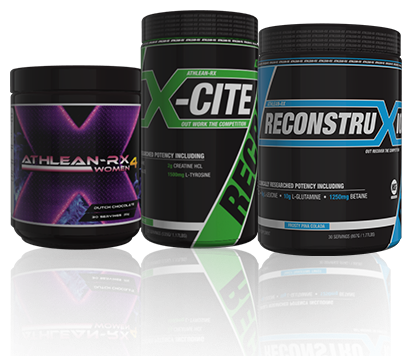

Original Price
$46.99
You Pay
$41.99
SUPPLEMENT
RX4
CHOOSE A FLAVOR
AMOUNT
 INDICATES SWEETENED WITH STEVIA
INDICATES SWEETENED WITH STEVIAAdd To Cart
Learn More
THE MISSING PIECE TO THE NUTRITIONAL PUZZLE
You work hard, train hard and eat right. You know your body needs more nutrients than what you're able to get from food. But you're not quite sure how to do that without consuming too many calories?
There's so many supplements available, and they all sound essential, where do you begin? Well look no further. AthLEAN-RX4 Women has formulated the definitive supplement for women. Featuring some of the most powerful ingredients available. AthLEAN-RX4 provides women with the missing piece to the nutritional puzzle.
No one has the time to get it exactly right at every meal.
The problem is, when it comes to nutrition, the body only gets the benefits of certain vitamins and minerals when they are regularly delivered over time. It's not something you can hit or miss. That's why we created AthLEAN-RX for Women. Now you can worry about other things knowing your body is getting the nutrients it needs to keep you going and looking your best . AthLEAN-RX4 Women is formulated to provide active women with exactly what they need exactly when they need it. No fillers, empty ingredients or false promises.
Whether you're a hardcore athlete or a busy mom always on the go ATHLEAN-RX4 has you covered.
ATHLEAN-RX4 Women contains many essential ingredients that women are typically deficient in such as: Calcium and Vitamin D for strong bones; Protein for developing lean toned muscles; and Iron for boosting the immune system and staving off anemia while providing mood stabilizing benefits. In addition, ATHLEAN-RX4 Women also features the latest breakthrough ingredients such as Co-Q-10 and Resveratrol for their anti-aging and antioxidant power and Papaya Enzyme to aid in digestion.
ATHLEAN RX-4 Women
ATHLEAN RX-4 CONTAINS: 3000 IU
CLINICAL STUDIES
Vitamin D has been used to boost athletic performance since 1927. It's especially effective for those who are deficient, which is most everyone. Vitamin D deficiency is related to cancer, depression, Alzheimer's and Parkinson's disease. Getting adequate amounts can prevent diabetes, lower blood pressure, and restore insulin sensitivity. Historically, athletes getting sunlamp exposure have experienced improvements in strength, speed, and endurance. Taking vitamin D while dieting may lead to faster fat loss, particularly in the abdominal area.
- Optimal muscle function
- Reduces inflammation
- Increases muscle protein synthesis
ATHLEAN RX-4 CONTAINS: 1,000 mg
CLINICAL STUDIES
Calcium is especially important for athletes because they are more likely to lose calcium, as well as other minerals, through perspiration. In addition to being important for strong bones, calcium is required for muscle contraction. Without enough calcium you may experience muscle cramps.
- Prevents muscle cramps
- Improves bone strength
ATHLEAN RX-4 CONTAINS: 8g
CLINICAL STUDIES
MCTs can increase fat oxidation, increase energy expenditure, and improve athletic performance. MCT consumption and MCFA oxidation appears to increase body fat oxidation and satiety compared to LCTs, which may expedite fat loss.
- Improves endurance
- Increases metabolic rate
- Promotes fat burning
- Maintains muscle mass
REFERENCES
Vitamin D
-
Ahmed W, Kahn N, Glueck CJ, et al. Low serum 25(OH) vitamin D levels (<32ng/ml) are associated with reversible myositis-myalgia in statin-treated patients. Transl Res. 2009;153(1):11-16 [PubMed]
-
Armas LA, Dowell S, Akhter M, et al. Ultraviolet-B radiation increases serum 25-hydroxyvitamin D levels: the effect of UVB dose and skin color. J Am Acad Dermatol. 2007;57(4):588-593 [PubMed]
-
Armas LA, Hollis BW, Heaney RP. Vitamin D2 is much less effective than vitamin D3 in humans. J Clin Endocrinol Metab. 2004;89(11):5387-5391 [PubMed]
-
Arnaud SB, Stickler GB, Haworth JC. Serum 25-hydroxyvitamin D in infantile rickets. Pediatrics. 1976;57(2):221-225 [PubMed]
-
Barger-Lux MJ, Heaney RP, Dowell S, Chen TC, Holick MF. Vitamin D and its major metabolites: serum levels after graded oral dosing in healthy men. Osteoporos Int. 1998;8(3):222-230 [PubMed]
-
Bartoszewska M, Kamboj M, Patel DR. Vitamin D, muscle function, and exercise performance. Pediatr Clin North Am. 2010;57(3):849-861 [PubMed]
-
Bikle DD. Vitamin D: newly discovered actions require reconsideration of physiologic requirements. Trends Endocrinol Metab. 2010;21(6):375-384 [PMC free article] [PubMed]
-
Birge SJ, Haddad JG. 25-hydroxycholecalciferol stimulation of muscle metabolism. J Clin Invest. 1975;56(5):1100-1107 [PMC free article] [PubMed]
-
Bischoff HA, Stähelin HB, Dick W, et al. Effects of vitamin D and calcium supplementation on falls: a randomized controlled trial. J Bone Miner Res. 2003;18(2):343-351 [PubMed]
-
Bischoff-Ferrari HA, Dietrich T, Orav EJ, Dawson-Hughes B. Positive association between 25-hydroxy vitamin D levels and bone mineral density: a population-based study of younger and older adults. Am J Med. 2004;116(9):634-639 [PubMed]
-
Bischoff-Ferrari HA, Dietrich T, Orav EJ, et al. Higher 25-hydroxyvitamin D concentrations are associated with better lower-extremity function in both active and inactive persons aged > or = 60 y. Am J Clin Nutr. 2004;80(3):752-758 [PubMed]
-
Bischoff-Ferrari HA, Giovannucci E, Willett WC, Dietrich T, Dawson-Hughes B. Estimation of optimal serum concentrations of 25-hydroxyvitamin D for multiple health outcomes. Am J Clin Nutr. 2006;84(1):18-28 [PubMed]
-
Bischoff-Ferrari HA, Willett WC, Wong JB, Giovannucci E, Dietrich T, Dawson-Hughes B. Fracture prevention with vitamin D supplementation: a meta-analysis of randomized controlled trials. JAMA. 2005;293(18):2257-2264 [PubMed]
-
Cannell JJ, Hollis BW, Sorenson MB, Taft TN, Anderson JJ. Athletic performance and vitamin D. Med Sci Sports Exerc. 2009;41(5):1102-1110 [PubMed]
-
Ceglia L. Vitamin D and its role in skeletal muscle. Curr Opin Clin Nutr Metab Care. 2009;12(6):628-633 [PMC free article] [PubMed]
-
Ceglia L. Vitamin D and skeletal muscle tissue and function. Mol Aspects Med. 2008;29(6):407-414 [PubMed]
- Cheatum BA. Effects of a single biodose of ultraviolet radiation upon the speed of college women. Res Q. 1968;39(3):482-485 [PubMed]
-
Chen TC, Chimeh F, Lu Z, et al. Factors that influence the cutaneous synthesis and dietary sources of vitamin D. Arch Biochem Biophys. 2007;460(2):213-217 [PMC free article] [PubMed]
-
Constantini NW, Arieli R, Chodick G, Dubnov-Raz G. High prevalence of vitamin D insufficiency in athletes and dancers. Clin J Sport Med. 2010;20(5):368-371 [PubMed]
-
Dawson-Hughes B. Serum 25-hydroxyvitamin D and muscle atrophy in the elderly. Proc Nutr Soc. 2012;71(1):46-49 [PubMed]
-
Dawson-Hughes B, Heaney RP, Holick MF, Lips P, Meunier PJ, Vieth R. Estimates of optimal vitamin D status. Osteoporos Int. 2005;16(7):713-716 [PubMed]
-
. de Torrenté de la Jara G, Pécoud A, Favrat B. Female asylum seekers with musculoskeletal pain: the importance of diagnosis and treatment of hypovitaminosis D. BMC Fam Pract. 2006;7:4. [PMC free article] [PubMed]
-
Dirks-Naylor AJ, Lennon-Edwards S. The effects of vitamin D on skeletal muscle function and cellular signaling. J Steroid Biochem Mol Biol. 2011;125(3-5):159-168 [PubMed]
-
Galan F, Ribas J, Sánchez-Martinez PM, Calero T, Sánchez AB, Muñoz A. Serum 25-hydroxyvitamin D in early autumn to ensure vitamin D sufficiency in mid-winter in professional football players. Clin Nutr. 2012;31(1):132-136 [PubMed]
-
Garland CF, Baggerly CA. Disease incidence prevention by serum 25(OH)D level. http://www.grassrootshealth.net/media/download/disease_incidence_prev_chart_101608.pdf Accessed January 22, 2012
-
Gibson JC, Stuart-Hill L, Martin S, Gaul C. Nutrition status of junior elite Canadian female soccer athletes. Int J Sport Nutr Exerc Metab. 2011;21(6):507-514 [PubMed]
-
Ginde AA, Liu MC, Camargo CA. Demographic differences and trends of vitamin D insufficiency in the US population, 1988-2004. Arch Intern Med. 2009;169(6):626-632 [PMC free article] [PubMed]
-
Gorkin Z, Gorkin MJ, Teslenko NE. The effect of ultraviolet irradiation upon training for 100m sprint. Fiziol Zh USSR. 1938;25:695-701
-
Haddad JG, Chyu KJ. Competitive protein-binding radioassay for 25-hydroxycholecalciferol. J Clin Endocrinol Metab. 1971;33(6):992-995 [PubMed]
-
Halliday TM, Peterson NJ, Thomas JJ, Kleppinger K, Hollis BW, Larson-Meyer DE. Vitamin D status relative to diet, lifestyle, injury, and illness in college athletes. Med Sci Sports Exerc. 2011;43(2):335-343 [PubMed]
-
Hamilton B. Vitamin D and human skeletal muscle. Scand J Med Sci Sports. 2010;20(2):182-190 [PMC free article] [PubMed]
-
Hathcock JN, Shao A, Vieth R, Heaney RP. Risk assessment for vitamin D. Am J Clin Nutr. 2007;85(1):6-18 [PubMed]
-
Heaney RP. Functional indices of vitamin D status and ramifications of vitamin D deficiency. Am J Clin Nutr. 2004;80(6):1706S-1709S [PubMed]
-
Heaney RP. Vitamin D: criteria for safety and efficacy. Nutr Rev. 2008;66(10)(suppl 2):S178-S181 [PubMed]
-
Heaney RP, Armas LA, Shary JR, Bell NH, Binkley N, Hollis BW. 25-Hydroxylation of vitamin D3: relation to circulating vitamin D3 under various input conditions. Am J Clin Nutr. 2008;87(6):1738-1742 [PubMed]
-
Heaney RP, Davies KM, Chen TC, Holick MF, Barger-Lux MJ. Human serum 25-hydroxycholecalciferol response to extended oral dosing with cholecalciferol. Am J Clin Nutr. 2003;77(1):204-210 [PubMed]
-
Hicks GE, Shardell M, Miller RR, et al. Associations between vitamin D status and pain in older adults: the Invecchiare in Chianti study. J Am Geriatr Soc. 2008;56:785-791 [PMC free article] [PubMed]
-
Higdon J, Drake VJ, DeLuca HF, Vitamin D. [Accessed January 22, 2012]. http://lpi.oregonstate.edu/infocenter/vitamins/vitaminD/
-
Holick MF. Sunlight “D”ilemma: risk of skin cancer or bone disease and muscle weakness. Lancet. 2001;357(9249):4-6 [PubMed]
-
Holick MF. Vitamin D deficiency. N Engl J Med. 2007;357(3):266-281 [PubMed]
-
Holick MF. The vitamin D deficiency pandemic and consequences for nonskeletal health: mechanisms of action. Mol Aspects Med. 2008;29(6):361-368 [PMC free article] [PubMed]
-
Holick MF. Vitamin D deficiency: what a pain it is. Mayo Clin Proc. 2003;78(12):1457-1459 [PubMed]
-
Hollis BW. Circulating 25-hydroxyvitamin D levels indicative of vitamin D sufficiency: implications for establishing a new effective dietary intake recommendation for vitamin D. J Nutr. 2005;135(2):317-322 [PubMed]
-
Hollis BW, Wagner CL, Drezner MK, Binkley NC. Circulating vitamin D3 and 25-hydroxyvitamin D in humans: an important tool to define adequate nutritional vitamin D status. J Steroid Biochem Mol Biol. 2007;103(3-5):631-634 [PMC free article] [PubMed]
-
Houston DK, Cesari M, Ferrucci L, et al. Association between vitamin D status and physical performance: the InCHIANTI Study. J Gerontol A Biol Sci Med Sci. 2007;62(4):440-446 [PMC free article] [PubMed]
-
Kumar J, Muntner P, Kaskel FJ, Hailpern SM, Melamed ML. Prevalence and associations of 25-hydroxyvitamin D deficiency in US children: NHANES 2001-2004. Pediatrics. 2009;124(3):362-370 [PMC free article] [PubMed]
-
Lappe J, Cullen D, Haynatzki G, Recker R, Ahlf R, Thompson K. Calcium and vitamin D supplementation decreases incidence of stress fractures in female navy recruits. J Bone Miner Res. 2008;23(5):741-749 [PubMed]
-
Lappe JM. The role of vitamin D in human health: a paradigm shift. J Evid Based Comp Alt Med. 2011;16:58-72
-
Larson-Meyer DE, Willis KS. Vitamin D and athletes. Curr Sports Med Rep. 2010;9(4):220-226 [PubMed]
-
Lehtonen-Veromaa M, Möttönen T, Irjala K, et al. Vitamin D intake is low and hypovitaminosis D common in healthy 9- to 15-year-old Finnish girls. Eur J Clin Nutr. 1999;53(9):746-751 [PubMed]
-
Looker AC, Pfeiffer CM, Lacher DA, Schleicher RL, Picciano MF, Yetley EA. Serum 25-hydroxyvitamin D status of the US population: 1988-1994 compared with 2000-2004. Am J Clin Nutr. 2008;88(6):1519-1527 [PMC free article] [PubMed]
-
Lovell G. Vitamin D status of females in an elite gymnastics program. Clin J Sport Med. 2008;18(2):159-161 [PubMed]
-
Mowé M, Haug E, Bøhmer T. Low serum calcidiol concentration in older adults with reduced muscular function. J Am Geriatr Soc. 1999;47(2):220-226 [PubMed]
-
Nesby-O’Dell S, Scanlon KS, Cogswell ME, et al. Hypovitaminosis D prevalence and determinants among African American and white women of reproductive age: third National Health and Nutrition Examination Survey, 1988-1994. Am J Clin Nutr. 2002;76(1):187-192 [PubMed]
-
News from the National Academies IOM report sets new dietary intake levels for calcium and vitamin D to maintain health and avoid risks associated with excess. http://www8.nationalacademies.org/onpinews/newsitem.aspx?RecordID=13050 Accessed January 22, 2012
-
Oh JH, Kim SH, Kim JH, Shin YH, Yoon JP, Oh CH. The level of vitamin D in the serum correlates with fatty degeneration of the muscles of the rotator cuff. J Bone Joint Surg Br. 2009;91(12):1587-1593 [PubMed]
-
Parade GW, Otto H. Effect of sunlamp on performance. Zeitschrift fur Klinische Medizin. 1940;137:17-21
-
Pfeifer M, Begerow B, Minne HW. Vitamin D and muscle function. Osteoporos Int. 2002;13(3):187-194 [PubMed]
-
Plotnikoff GA, Quigley JM. Prevalence of severe hypovitaminosis D in patients with persistent, nonspecific musculoskeletal pain. Mayo Clin Proc. 2003;78(12):1463-1470 [PubMed]
-
Rodman JS, Baker T. Changes in the kinetics of muscle contraction in vitamin D-depleted rats. Kidney Int. 1978;13(3):189-193 [PubMed]
-
Rosentsweig J. The effect of a single suberythemic biodose of ultraviolet radiation upon the strength of college women. J Assoc Phys Ment Rehabil. 1967;21(4):131-133 [PubMed]
-
Ruohola JP, Laaksi I, Ylikomi T, et al. Association between serum 25(OH)D concentrations and bone stress fractures in Finnish young men. J Bone Miner Res. 2006;21(9):1483-1488 [PubMed]
-
Sato Y, Iwamoto J, Kanoko T, Satoh K. Low-dose vitamin D prevents muscular atrophy and reduces falls and hip fractures in women after stroke: a randomized controlled trial. Cerebrovasc Dis. 2005;20(3):187-192 [PubMed]
-
Shindle MK, Voos JE, Gulotta L, et al. Vitamin D status in a professional American football team [ID 46-9849]. AOSSM Annual Meeting; San Diego, CA; 2011
-
Sigmund R. Effect of ultraviolet rays on reaction time in man. Strahlentherapie. 1956;101(4):623-629 [PubMed]
-
Sørensen OH, Lund B, Saltin B, et al. Myopathy in bone loss of ageing: improvement by treatment with 1 alpha-hydroxycholecalciferol and calcium. Clin Sci (Lond). 1979;56(2):157-161 [PubMed]
-
Tavera-Mendoza LE, White JH. Cell defenses and the sunshine vitamin. Sci Am. 2007;297(5):62-65, 68,-70, 72 [PubMed]
-
Trang HM, Cole DE, Rubin LA, Pierratos A, Siu S, Vieth R. Evidence that vitamin D3 increases serum 25-hydroxyvitamin D more efficiently than does vitamin D2. Am J Clin Nutr. 1998;68(4):854-858 [PubMed]
-
Välimäki VV, Alfthan H, Lehmuskallio E, et al. Vitamin D status as a determinant of peak bone mass in young Finnish men. J Clin Endocrinol Metab. 2004;89(1):76-80 [PubMed]
-
Ward KA, Das G, Berry JL, et al. Vitamin D status and muscle function in post-menarchal adolescent girls. J Clin Endocrinol Metab. 2009;94(2):559-563 [PubMed]
-
Wassner SJ, Li JB, Sperduto A, Norman ME. Vitamin D deficiency, hypocalcemia, and increased skeletal muscle degradation in rats. J Clin Invest. 1983;72(1):102-112 [PMC free article] [PubMed]
-
Wicherts IS, van Schoor NM, Boeke AJ, et al. Vitamin D status predicts physical performance and its decline in older persons. J Clin Endocrinol Metab. 2007;92(6):2058-2065 [PubMed]
-
Willis KS. Vitamin D Status and Immune System Biomarkers in Athletes. Laramie, WI: University of Wyoming; 2008:85
-
Willis KS, Peterson NJ, Larson-Meyer DE. Should we be concerned about the vitamin D status of athletes? Int J Sport Nutr Exerc Metab. 2008;18(2):204-224 [PubMed]
-
Wortsman J, Matsuoka LY, Chen TC, Lu Z, Holick MF. Decreased bioavailability of vitamin D in obesity. Am J Clin Nutr. 2000;72(3):690-693 [PubMed]
-
Yetley EA. Assessing the vitamin D status of the US population. Am J Clin Nutr. 2008;88(2):558S-564S [PubMed]
-
Young A, Edwards RHT, Jones DA, Brenton DP. Quadriceps muscle strength and fibre size during treatment of osteomalacia. In: Stokes IAF, editor. , ed. Mechanical Factors and the Skeleton. Vol 12 London, UK: John Libbey, 1981:137-145
Calcium
-
Antonio J, Stout JR. Sports Supplements. Philadelphia: Lippincott Williams & Wilkins, 2001.
-
Antonio J, Stout JR. Supplements for Endurance Athletes. Champaign, IL: Human Kinetics, 2002.
-
Armsey, TD Jr, Green GA. Nutrition Supplements: Science vs. Hype. Phys Sportsmed. 1997;25.
-
Berardi J. Improving the Immune Systems of Athletes: Nutrition and Supplements. JohnBerardi.com (Science Link, Inc). Available from URL: www.johnberardi.com/articles/supplementation/immunesys.htm
-
Bucci LR. Nutritional Ergogenic Aids. In: Wolinsky I, Hickson JF, eds. Nutrition in Exercise and Sport, 2nd ed. Boca Raton: CRC Press, 1994:295-346.
-
Burke E, Gastelu D. Avery’s Sports Nutrition Almanac. Garden City Park, NY: Avery Publishing Group, 1999.
-
Burke E. Optimal Muscle Recovery. New York: Avery, 1999.
-
Colgan M. Plant Sterols and Sterolins. Colgan Chronicles Newsletter 1999 Jan;3.
-
Cylwik D, Mogielnicki A, Buczko W. L-arginine and cardiovascular system. Pharmacol Rep2005;57:14–22 [review].
-
DerMarderosian A, Beutler JA, eds. The Review of Natural Products: The Most Complete Source of Natural Product Information, 3rd ed. St. Louis: Facts and Comparisons, 2002.
-
De Schepper L. Going for the Gold: Homeopathy for Sports Injuries. The Renaissance Institute of Classical Homeopathy. Available from URL: www.drluc.com/sports.html
-
Feuer L, Farkas L, Nogradi M. Metabolic 5-methyl-isoflavone-derivatives, process for the preparation thereof and compositions containing the same. 1979 Aug 7; United States Patent 4,163,746.
-
5-Hydroxytryptophan (Monograph). Altern Med Review1998;3:224–6.
-
Gilbey A, Perezgonzalez JD. Health benefits of deer and elk velvet antler supplements: a systematic review of randomised controlled studies. N Z Med J2012;125:80-6.
-
Hammond, C. The Complete Family Guide to Homeopathy. New York: Penguin Studio, 1995.
-
Kelly G. Bromelain: A Literature Review and Discussion of its Therapeutic Applications. Altern Med Rev1996:1. Available from URL: www.thorne.com/altmedrev/fulltext/bromelain1-4.html
-
Le Boucher J, Cynober LA. Ornithine alpha-ketoglutarate: the puzzle. Nutrition1998;14:870–3 [review].
-
Moro CO, Basile G. Obesity and medicinal plants. Fitoterapia2000;71:S73–S82 [review].
-
Morrison D. Eucalyptus From Head to Toe. Alive: Canadian Journal of Health & Nutrition2000;215:90.
-
Murray MT. Encyclopedia of Nutritional Supplements. Rocklin, CA: Prima, 1996.
-
National Council against Health Fraud (NCAHF). Natural Products for Athletic Performance. NCAHF Newsletter 1994 Jan/Feb;17.
-
Nutros.com (Nutros Sports Nutritional Supplements, LLC). URL: www.nutros.com
-
Van Straten M. Guarana: The Energy Seeds and Herbs of the Amazon Rainforest. Saffron Walden, Essex, UK: C.W. Daniel Company, 1994.
-
Wernerman J, Hammarqvist F, Vinnars E. Alpha-ketoglutarate and postoperative muscle catabolism. Lancet 1990;335:701–3.
-
Hammarqvist F, Wernerman J, von der Decken A, Vinnars E. Alpha-ketoglutarate preserves protein synthesis and free glutamine in skeletal muscle after surgery. Surgery1991;109:28–36.
-
Poster presentations at the annual meeting of the International Society of Sports Nutrition. Sports Nutr Rev J 2004;1:S10–S13.
-
Sleivert G, Burke V, Palmer C, Walmsley A, Gerrard D, Haines S, Littlejohn R. The effects of deer antler velvet extract or powder supplementation on aerobic power, erythropoiesis, and muscular strength and endurance characteristics. Int J Sport Nutr Exerc Metab. 2003;13:251-65.
-
Syrotuik DG, MacFadyen KL, Harber VJ, Bell GJ. Effect of elk velvet antler supplementation on the hormonal response to acute and chronic exercise in male and female rowers. Int J Sport Nutr Exerc Metab. 2005;15:366-85.
MCT’s
-
Fushiki T, Matsumoto K, Inoue K, Kawada T, Sugimoto E. Swimming endurance capacity of mice is increased by chronic consumption of medium-chain triglycerides. J Nutr 1995 Mar;125(3):531-9.
-
Scalfi L, Coltorti A, Contaldo F. Postprandial thermogenesis in lean and obese subjects after meals supplemented with medium-chain and long-chain triglycerides. Am J Clin Nutr 1991 May;53(5):1130-3.
-
Hainer V, Kunesova M, Stich V, Zak A, Parizkova J. The role of oils containing triacylglycerols and medium-chain fatty acids in the dietary treatment of obesity. The effect on resting energy expenditure and serum lipids. Cas Lek Cesk 1994 Jun 13;133(12):373-5.
-
Flatt, J. P., Ravussin, E., Acheson, K. J. & Jequier, E. (1985) Effects of dietary fat on postprandial substrate oxidation and on carbohydrate and fat balances. J. Clin. Investig. 76:1019-1024.
-
Stubbs, R. J. & Harbron, C. G. (1996) Covert manipulation of the ration of medium- to long-chain triglycerides in isoenergetically dense diets: effect on food intake in ad libitum feeding men. Int. J. Obes. 20:435-444.
-
“Medium Chain Triglycerides (MCTs): Uses, Side Effects, Interactions and Warnings.” WebMD. N.p., 2015.
-
Ward, Dean, and Jim English. “Medium Chain Triglycerides (MCTs).” Nutrition Review. N.p., 22 Apr. 2013.
-
Triglyceride Consumption Relative to Long-chain Triglyceride is Associated with Lower Initial Body …” National Center for Biotechnology Information. PubMed, Dec. 2003.
-
St-Onge, Marie-Pierre, and Aubrey Bosarge. “Weight-Loss Diet That Includes Consumption of Medium-Chain Triacylglycerol Oil Leads to a Greater Rate of Weight and Fat Mass Loss than Does Olive Oil.” The American journal of clinical nutrition 87.3 (2008): 621–626.
-
Tanchoco, C. C., et al. “Diet Supplemented with MCT Oil in the Management of Childhood Diarrhea.” National Center for Biotechnology Information. PubMed, 2007.
-
St-Onge, Marie-Pierre et al. “Medium Chain Triglyceride Oil Consumption as Part of a Weight Loss Diet Does Not Lead to an Adverse Metabolic Profile When Compared to Olive Oil.” Journal of the American College of Nutrition 27.5 (2008): 547–552.
-
Wanten, G. J., and A. H. Naber. “Cellular and Physiological Effects of Medium-chain Triglycerides.” National Center for Biotechnology Information. PubMed, Oct. 2004.
-
“Immunomodulators.” Crohn’s & Colitis Foundation of America. N.p., 16 Jan. 2009.
-
Tisdale, M. J., and R. A. Brennan. “A Comparison of Long-chain Triglycerides and Medium-chain Triglycerides on Weight Loss and Tumour Size in a Cachexia Model.” National Center for Biotechnology Information. PubMed, Nov. 1988.
